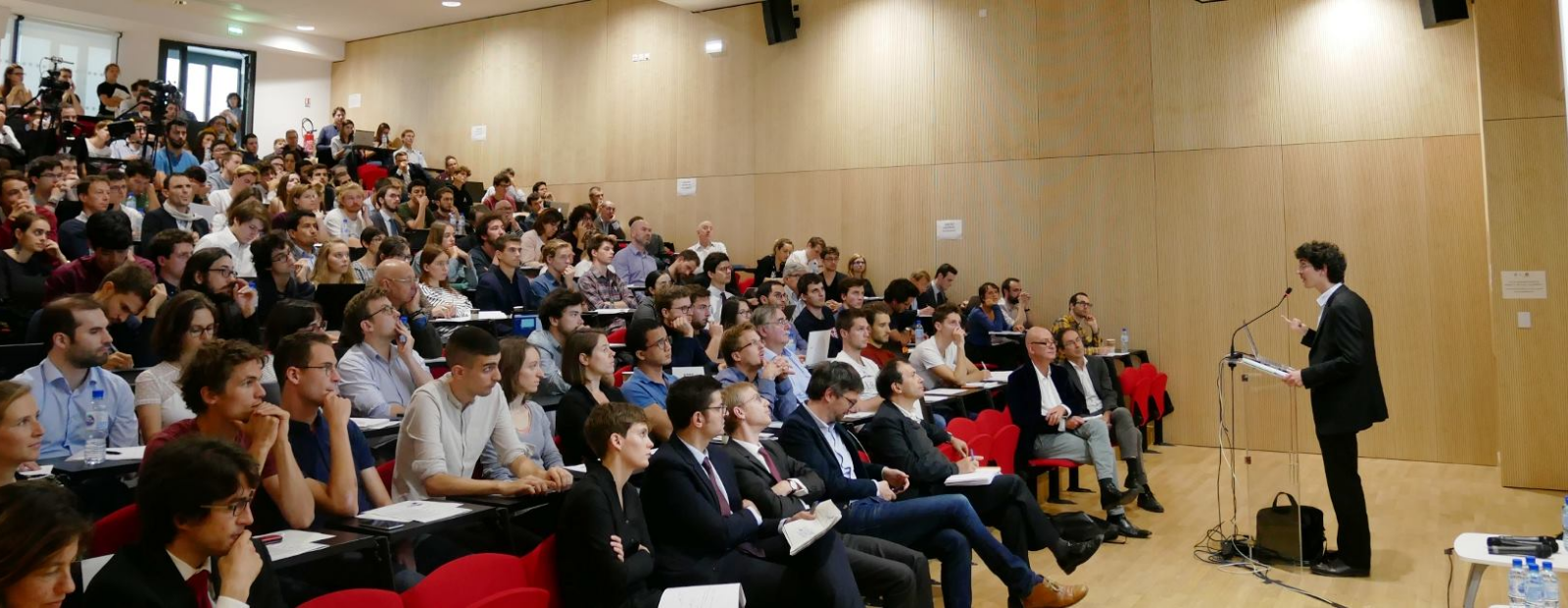Publié en

Katheline Schubert
Professeure émérite à PSE et porteuse de la Chaire Réussir la transition énergétique
CV EN ANGLAIS- Professeure émérite
- Université Paris 1 Panthéon-Sorbonne
- Chercheur associé à la Chaire Réussir la transition énergétique.
- Croissance et développement durable
- Economie du changement climatique
- Fiscalité verte
- Transition énergétique
Adresse :48 boulevard Jourdan,
75014 Paris, France
Onglets
Welcome to my professional homepage.
I am professor of economics at University Paris 1 Panthéon-Sorbonne and associate chair at Paris School of Economics.
I am also:
member of the Franch High Council for Climate (Haut Conseil pour le Climat),
member of the French Council of Economic Analysis (Conseil d’Analyse Economique, CAE),
member of the French Economic Council of Sustainable Development (Conseil Economique du Dévelopement Durable, CEDD),
CESIfo research fellow,
co-director of the Globalization, development and environment program at CEPREMAP,
past president of the French Economic Association (AFSE),
associate editor of the European Economic Review,
editor of the Journal of Environmental Economics and Management
co-editor of Resource and Energy Economics.
My current research interests are in environmental and natural resource economics and in climate economics.
Recent publications
Selected peer-reviewed publications
The Economics of Border Carbon Adjustment: Rationale and Impacts of Compensating for Carbon at the Border, Annual Reviews of Economics, to appear, 2023 (with Lionel Fontagné).
Critical raw materials for the energy transition, European Economic Review, 141, 2022 (with Francesco Ricci and Aude Pommeret).
Optimal energy transition with variable and intermittent renewable electricity generation, Journal of Economic Dynamics and Control, 134, 2022 (with Aude Pommeret).
Benefit-Cost Analysis for climate action, Journal of Benefit-Cost Analysis, 12(3), 494-517, 2021 (with Dominique Bureau and Alain Quinet).
Prevention and mitigation of epidemics: biodiversity conservation and confinement policies. Journal of Mathematical Economics, 93, 2021 (with Emmanuelle Augeraud-Véron and Giorgio Fabbri).
Unilateral CO2 reduction policy with more than one carbon energy source. Journal of the Association of Environmental and Resource Economists, 8(3), 2021 (with Julien Daubanes and Fanny Henriet).
Volatility-reducing biodiversity conservation under strategic interactions, Ecological Economics, 190, 2021 (with Emmanuelle Augeraud-Véron and Giorgio Fabbri).
How important are uncertainty and dynamics for environmental and climate policy? Some analytics. Journal of Environmental Economics and Management, 97, 1-22, 2019 (with Sjak Smulders).
The value of biodiversity as an insurance device. American Journal of Agricultural Economics, 101(4), 1068-1081, 2019 (with Emmanuielle Augeraud-Véron and Giorgio Fabbri).
Is shale gas a good bridge to renewables? An application to Europe. Environmental and Resource Economics, 72(3), 721-762, 2019 (with Fanny Henriet).
Intertemporal emission permits trading under uncertainty and irreversibility. Environmental and Resource Economics, 71(1), 75-97, 2018 (with Aude Pommeret).
To what extent is aquaculture socially beneficial? A theoretical analysis, American Journal of Agricultural Economics, 99(1), 186-206, 2017 (with Esther Regnier).
Should the carbon price be the same in all countries? Journal of Public Economic Theory, 18(5), 709–724, 2016 (with Antoine d’Autume and Cees Withagen).
A never-decisive and anonymous criterion for optimal growth models, Economic Theory, 55, 281-306, 2014 (with Alain Ayong Le Kama, Thai Ha-Huy and Cuong Le Van).
A stylized applied energy-economy model for France, The Energy Journal, 35(4), 1-38, 2014 (with Fanny Henriet and Nicolas Maggiar).
Carbon tax and OPEC’s rents under a ceiling constraint, Scandinavian Journal of Economics, 113(4), 798-824, 2011 (with Rémy Dullieux and Lionel Ragot).
Optimal use of a polluting non-renewable resource generating both manageable and catastrophic damages, Annals of Economics and Statistics, 103/104, 107-142, 2011 (with Jean-Pierre Amigues and Michel Moreaux).
With exhaustible resources, can a developing country escape from the poverty trap? Journal of Economic Theory, 145(6), 2435-2447, 2010 (with Cuong Le Van and Thu Anh Nguyen).
Demographic-economic equilibria when the age at motherhood is endogenous, Journal of Mathematical Economics, 46(6), 1211-1221, 2010 (with Hippolyte d’Albis and Emmanuelle Augeraud-Véron).
The zero discounting and maximin optimal paths in a simple model of global warming, Mathematical Social Sciences, 59(2), 193-207, 2010 (with Antoine d’Autume and John M. Hartwick).
Abatement technology adoption under uncertainty, Macroeconomic Dynamics, 13(4), 493-522, 2009 (with Aude Pommeret).
Zero discounting and optimal path of depletion of an exhaustible resource with an amenity value, Revue d’Economie Politique, 119(6), 827-845, 2008 (with Antoine d’Autume).
Hartwick’s rule and maximin paths when the exhaustible resource has an amenity value, Journal of Environmental Economics and Management, 56(3), 260-274, 2008 (with Antoine d’Autume).
The optimal carbon sequestration in agricultural soils: do the dynamics of the physical process matter? Journal of Economic Dynamics and Control, 32(12), 3847-3865, 2008 (with Lionel Ragot).
Books and reports
Le triple défi de la réforme du marché européen de l’électricité, Conseil d’analyse économique, n°76, 2023 (with Dominique Bureau et Jean-Michel Glachant).
La transition énergétique : objectif ZEN, Opuscule du CEPREMAP n°57, Editions rue d’Ulm, 2021 (with Fanny Henriet).
Biodiversité en danger : quelle réponse économique ? Conseil d’analyse économique, n°59, 2020 (with Dominique Bureau and Jean-Christophe Bureau).
Pour le climat : une taxe juste, pas juste une taxe. Conseil d’analyse économique, n°50, 2019 (with Dominique Bureau and Fanny Henriet).
L’impact de l’Accord Économique et Commercial Global entre l’Union européenne et le Canada (AECG/CETA) sur l’environnement, le climat et la santé, Rapport au Premier ministre, 2017.
Commerce et climat : pour une réconciliation. Conseil d’analyse économique, n°37, 2017 (with Dominique Bureau and Lionel Fontagné).
Pour la taxe carbone. La politique économique face à la menace climatique, Opuscule du CEPREMAP n°18, Editions rue d’Ulm, 2009.
Macroeconomics (growth), L3 Magistère, Université Paris 1
Natural resources and climate change, M1, Université Paris 1
Natural resources and climate change economics, M2 APE (cours Environmental Economics, avec Mireille Chiroleu-Assouline)
Natural resources and development, M2 PPD (avec François Libois)
Publications HAL
-
Gouverner. Un enjeu essentiel OuvragesAuteur : Fanny Henriet, Philippe Askenazy, Thomas Renault Éditeur : Odile Jacob
-
Chosen Energy Sufficiency: Preference Shocks and Behavioural Biases Article dans une revueRevue : Economie et Statistique / Economics and Statistics
Publié en
-
The Economics of Border Carbon Adjustment: Rationale and Impacts of Compensating for Carbon at the Border Article dans une revueRevue : Annual Review of Economics
Publié en
-
Confronting the carbon pricing gap: Second best climate policy Pré-publication, Document de travailAuteur : Francesco Ricci
Publié en
-
Confronting the Carbon Pricing Gap: Second Best Climate Policy Communication dans un congrèsAuteur : Francesco Ricci
Publié en
-
Confronting the Carbon Pricing Gap: Second Best Climate Policy Communication dans un congrèsAuteur : Francesco Ricci
Publié en
-
Confronting the Carbon Pricing Gap: Second Best Climate Policy Communication dans un congrèsAuteur : Francesco Ricci
Publié en
-
Confronting the Carbon Pricing Gap: Second Best Climate Policy Communication dans un congrèsAuteur : Francesco Ricci
Publié en
-
Optimal energy transition with variable and intermittent renewable electricity generation Article dans une revueRevue : Journal of Economic Dynamics and Control
Publié en
-
Critical raw materials for the energy transition Article dans une revueAuteur : Francesco Ricci Revue : European Economic Review
Publié en
